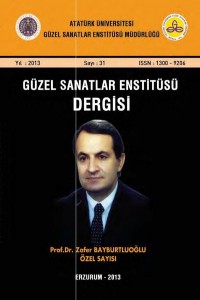Abstract
Kemah Castle Excavation has been continuing under the direction of Professor Dr. Hüseyin YURTTAŞ since 2010, due to article 35 of the law number 2863, and with the permission verdict of Ministry Council number 2010/721, in connection with the Ministry of Culture and Tourism and Atatürk University. Castle Road, Guard Rooms, Bey Mosque, Structure of Hamam, and opening the Routes of Walkways are determined as workspaces in Kemah Castle Excavation. 198 pieces of both manuscript and published Holly Qur’an, and books written in various issues were found in domed area of the south-west side of Palace Hamam in 2012. Besides, a lot of pieces of glazed and unglazed ceramics, and gypsum parts in geometric size and shapes with animal figures were also found out during the excavation.
Keywords
References
- Erzen, A. (1979). Eastern Anatolia and Urartians, İstanbul.
- Al-Balâzur ( 1866). Fütuhu’l-Buldan, (Çev. De Goeje), Leiden.
- Luckanbıl, D.D. (1926). Ancient Records of Assyria and Babylonia I, Chicago.
- Will, E. (1967). Historie Politique du monde Hellenistique, II, Nancy.
- Ko şay, H. Z. (1974). Erzurum ve Çevresinin Dip Tarihi, 50. Yıl Armağanı: Erzurum ve Çevresi I, Erzurum.
- Önkal, H. (1996). Anadolu Selçuklu Türbeleri, Ankara.
- Miro ğlu, İ. (1990). Kemah Sancağı ve Erzincan Kazası (1520-1566), Ankara. Şahin, İ. (2002). “Kemah” Mad., TDV. İslam Ansiklopedisi, C. 25, Ankara, 219-220
- İbnü’l Esir Tarihü’l-Kâmil, (Çev. Tornberg), Upsala-Leyden, 1851-1876, III. Garstang J.- Gurney O. R. (1969). The Geography of the Hitite Empire, London.
- Salvini, M. (1967). Nairi e Ur(u)atri, Roma.
- Yınanç, M.H. (1944). Türkiye Tarihi, Selçuklular Devri, I Anadolu’nun Fethi Aslanapa, O. (1973). Türk Sanatı, İstanbul.
- Tuncer, O. C. (1986). Anadolu Kümbetleri I (Selçuklu Dönemi), Ankara.
- Turan, O.(1973) Do ğu Anadolu Türk Devletleri Tarihi, İstanbul.
- Turan, O.(1971). Selçuklular Zamanında Türkiye, İstanbul.
- Özgüç, T. (1962). “Mengüceklilere Ait Bir Türbe”, Millerarası I. Türk Sanatları Kongresi, Ankara, 321-348.
- Kurt, Y. (1996). Kemah Kitabı “Bir Derkenar”, Ankara. Çiz. 1: Kemah Kalesi.
- Çiz. 2: Bey Camii Planı Çiz. 3: Bey Camii.
Abstract
2863 Sayılı Kanunun 35. Maddesi çerçevesinde Kültür ve Turizm
Bakanlığı ile Atatürk Üniversitesi adına Bakanlar Kurulu’nun 2010/721 sayılı
kararı ile 2010 yılından itibaren Erzincan İli Kemah İlçesi Kemah Kalesi
Kazısı Prof. Dr. Hüseyin YURTTAŞ’ın başkanlığında yapılmaktadır. Kemah
Kalesi Kazısı çalışmalarında, Kale Yolu ve Muhafız Odaları, Bey Camii,
Hamam Yapısı ve Yürüme Yollarının Açılması çalışma alanları olarak
belirlenmiştir. 2012 yılında Saray Hamamının güneybatısındaki kubbeli
mekânda 198 parça tam olmayan el yazması ve matbu Kuran-ı Kerimler ve
çeşitli konularda yazılmış kitap parçaları bulunmuştur. Ayrıca çok sayıda sırlı
ve sırsız seramik parçaları ile geometrik, bitkisel, yazılı ve hayvan figürlü
olmak üzere bir kısım alçı parçaları ele geçirilmiştir.
Anahtar Kelimeler: Kemah, Kemah Kalesi, Bey Camii, Saray Hamamı.
Abstract
Kemah Castle Excavation has been continuing under the direction of
Professor Dr. Hüseyin YURTTAŞ since 2010, due to article 35 of the law
number 2863, and with the permission verdict of Ministry Council number
2010/721, in connection with the Ministry of Culture and Tourism and
Atatürk University. Castle Road, Guard Rooms, Bey Mosque, Structure of
Hamam, and opening the Routes of Walkways are determined as workspaces
in Kemah Castle Excavation. 198 pieces of both manuscript and published
Holly Qur’an, and books written in various issues were found in domed area
of the south-west side of Palace Hamam in 2012. Besides, a lot of pieces of
glazed and unglazed ceramics, and gypsum parts in geometric size and
shapes with animal figures were also found out during the excavation.
Keywords: Kemah, Kemah Castle, Bey Mosque, Structure of Hamam.
Keywords
References
- Erzen, A. (1979). Eastern Anatolia and Urartians, İstanbul.
- Al-Balâzur ( 1866). Fütuhu’l-Buldan, (Çev. De Goeje), Leiden.
- Luckanbıl, D.D. (1926). Ancient Records of Assyria and Babylonia I, Chicago.
- Will, E. (1967). Historie Politique du monde Hellenistique, II, Nancy.
- Ko şay, H. Z. (1974). Erzurum ve Çevresinin Dip Tarihi, 50. Yıl Armağanı: Erzurum ve Çevresi I, Erzurum.
- Önkal, H. (1996). Anadolu Selçuklu Türbeleri, Ankara.
- Miro ğlu, İ. (1990). Kemah Sancağı ve Erzincan Kazası (1520-1566), Ankara. Şahin, İ. (2002). “Kemah” Mad., TDV. İslam Ansiklopedisi, C. 25, Ankara, 219-220
- İbnü’l Esir Tarihü’l-Kâmil, (Çev. Tornberg), Upsala-Leyden, 1851-1876, III. Garstang J.- Gurney O. R. (1969). The Geography of the Hitite Empire, London.
- Salvini, M. (1967). Nairi e Ur(u)atri, Roma.
- Yınanç, M.H. (1944). Türkiye Tarihi, Selçuklular Devri, I Anadolu’nun Fethi Aslanapa, O. (1973). Türk Sanatı, İstanbul.
- Tuncer, O. C. (1986). Anadolu Kümbetleri I (Selçuklu Dönemi), Ankara.
- Turan, O.(1973) Do ğu Anadolu Türk Devletleri Tarihi, İstanbul.
- Turan, O.(1971). Selçuklular Zamanında Türkiye, İstanbul.
- Özgüç, T. (1962). “Mengüceklilere Ait Bir Türbe”, Millerarası I. Türk Sanatları Kongresi, Ankara, 321-348.
- Kurt, Y. (1996). Kemah Kitabı “Bir Derkenar”, Ankara. Çiz. 1: Kemah Kalesi.
- Çiz. 2: Bey Camii Planı Çiz. 3: Bey Camii.
Details
| Primary Language | tr;en |
|---|---|
| Journal Section | Articles |
| Authors | |
| Publication Date | May 2, 2014 |
| Submission Date | May 2, 2014 |
| Published in Issue | Year 2013 Issue: 31 |
Obtaining permissions for studies requiring ethics committee approval regarding the implementation of ethical rules and including information about permission in the article was added to the criteria. In this direction, Ethics Committee Permission is required for articles submitted to our journal and meeting the conditions stated below.
• Any research conducted with qualitative or quantitative approaches that require data collection from participants using questionnaires, interviews, focus group work, observation, experimentation, and interview techniques.
Also;
• Obtaining and indicating permission from the owners for the use of scales, surveys and photographs belonging to others,
• It should be stated that the copyright regulations are complied with for the intellectual and artistic works used.

